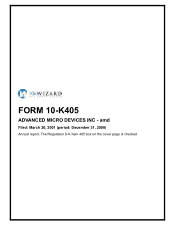AMD 2000 Annual Report Download - page 6
Download and view the complete annual report
Please find page 6 of the 2000 AMD annual report below. You can navigate through the pages in the report by either clicking on the pages listed below, or by using the keyword search tool below to find specific information within the annual report.-
 1
1 -
 2
2 -
 3
3 -
 4
4 -
 5
5 -
 6
6 -
 7
7 -
 8
8 -
 9
9 -
 10
10 -
 11
11 -
 12
12 -
 13
13 -
 14
14 -
 15
15 -
 16
16 -
 17
17 -
 18
18 -
 19
19 -
 20
20 -
 21
21 -
 22
22 -
 23
23 -
 24
24 -
 25
25 -
 26
26 -
 27
27 -
 28
28 -
 29
29 -
 30
30 -
 31
31 -
 32
32 -
 33
33 -
 34
34 -
 35
35 -
 36
36 -
 37
37 -
 38
38 -
 39
39 -
 40
40 -
 41
41 -
 42
42 -
 43
43 -
 44
44 -
 45
45 -
 46
46 -
 47
47 -
 48
48 -
 49
49 -
 50
50 -
 51
51 -
 52
52 -
 53
53 -
 54
54 -
 55
55 -
 56
56 -
 57
57 -
 58
58 -
 59
59 -
 60
60 -
 61
61 -
 62
62 -
 63
63 -
 64
64 -
 65
65 -
 66
66 -
 67
67 -
 68
68 -
 69
69 -
 70
70 -
 71
71 -
 72
72 -
 73
73 -
 74
74 -
 75
75 -
 76
76 -
 77
77 -
 78
78 -
 79
79 -
 80
80 -
 81
81 -
 82
82 -
 83
83 -
 84
84 -
 85
85 -
 86
86 -
 87
87 -
 88
88 -
 89
89 -
 90
90 -
 91
91 -
 92
92 -
 93
93 -
 94
94 -
 95
95 -
 96
96 -
 97
97 -
 98
98 -
 99
99 -
 100
100 -
 101
101 -
 102
102 -
 103
103 -
 104
104 -
 105
105 -
 106
106 -
 107
107 -
 108
108 -
 109
109 -
 110
110 -
 111
111 -
 112
112 -
 113
113 -
 114
114 -
 115
115 -
 116
116 -
 117
117 -
 118
118 -
 119
119 -
 120
120 -
 121
121 -
 122
122 -
 123
123 -
 124
124 -
 125
125 -
 126
126 -
 127
127 -
 128
128 -
 129
129 -
 130
130 -
 131
131 -
 132
132 -
 133
133 -
 134
134 -
 135
135 -
 136
136 -
 137
137 -
 138
138 -
 139
139 -
 140
140 -
 141
141 -
 142
142 -
 143
143 -
 144
144 -
 145
145 -
 146
146 -
 147
147 -
 148
148 -
 149
149 -
 150
150 -
 151
151 -
 152
152 -
 153
153 -
 154
154 -
 155
155 -
 156
156 -
 157
157 -
 158
158 -
 159
159 -
 160
160 -
 161
161 -
 162
162 -
 163
163 -
 164
164 -
 165
165 -
 166
166 -
 167
167 -
 168
168 -
 169
169 -
 170
170 -
 171
171 -
 172
172 -
 173
173 -
 174
174 -
 175
175 -
 176
176 -
 177
177 -
 178
178 -
 179
179 -
 180
180 -
 181
181 -
 182
182 -
 183
183 -
 184
184 -
 185
185 -
 186
186 -
 187
187 -
 188
188 -
 189
189 -
 190
190 -
 191
191 -
 192
192 -
 193
193 -
 194
194 -
 195
195 -
 196
196 -
 197
197 -
 198
198 -
 199
199 -
 200
200 -
 201
201 -
 202
202 -
 203
203 -
 204
204 -
 205
205 -
 206
206 -
 207
207 -
 208
208 -
 209
209 -
 210
210 -
 211
211 -
 212
212 -
 213
213 -
 214
214 -
 215
215 -
 216
216 -
 217
217 -
 218
218 -
 219
219 -
 220
220 -
 221
221 -
 222
222 -
 223
223 -
 224
224 -
 225
225 -
 226
226 -
 227
227 -
 228
228 -
 229
229 -
 230
230 -
 231
231 -
 232
232 -
 233
233 -
 234
234 -
 235
235 -
 236
236 -
 237
237 -
 238
238 -
 239
239 -
 240
240 -
 241
241 -
 242
242 -
 243
243 -
 244
244 -
 245
245 -
 246
246 -
 247
247 -
 248
248 -
 249
249 -
 250
250 -
 251
251 -
 252
252 -
 253
253 -
 254
254 -
 255
255 -
 256
256 -
 257
257 -
 258
258 -
 259
259 -
 260
260 -
 261
261 -
 262
262 -
 263
263 -
 264
264 -
 265
265 -
 266
266 -
 267
267 -
 268
268 -
 269
269 -
 270
270 -
 271
271 -
 272
272 -
 273
273 -
 274
274 -
 275
275 -
 276
276 -
 277
277 -
 278
278 -
 279
279 -
 280
280 -
 281
281 -
 282
282 -
 283
283 -
 284
284 -
 285
285 -
 286
286 -
 287
287 -
 288
288 -
 289
289 -
 290
290 -
 291
291 -
 292
292 -
 293
293 -
 294
294 -
 295
295 -
 296
296 -
 297
297 -
 298
298 -
 299
299 -
 300
300 -
 301
301 -
 302
302 -
 303
303 -
 304
304 -
 305
305 -
 306
306 -
 307
307 -
 308
308 -
 309
309 -
 310
310 -
 311
311 -
 312
312 -
 313
313 -
 314
314 -
 315
315 -
 316
316 -
 317
317 -
 318
318 -
 319
319 -
 320
320 -
 321
321 -
 322
322 -
 323
323 -
 324
324 -
 325
325 -
 326
326 -
 327
327 -
 328
328 -
 329
329 -
 330
330 -
 331
331 -
 332
332 -
 333
333 -
 334
334 -
 335
335 -
 336
336 -
 337
337 -
 338
338 -
 339
339 -
 340
340 -
 341
341 -
 342
342 -
 343
343 -
 344
344 -
 345
345 -
 346
346 -
 347
347 -
 348
348 -
 349
349 -
 350
350 -
 351
351 -
 352
352 -
 353
353 -
 354
354 -
 355
355 -
 356
356 -
 357
357 -
 358
358 -
 359
359 -
 360
360 -
 361
361 -
 362
362 -
 363
363 -
 364
364 -
 365
365 -
 366
366 -
 367
367 -
 368
368 -
 369
369 -
 370
370 -
 371
371 -
 372
372 -
 373
373 -
 374
374 -
 375
375 -
 376
376 -
 377
377 -
 378
378 -
 379
379 -
 380
380 -
 381
381 -
 382
382 -
 383
383 -
 384
384 -
 385
385 -
 386
386 -
 387
387 -
 388
388 -
 389
389 -
 390
390 -
 391
391 -
 392
392 -
 393
393 -
 394
394 -
 395
395 -
 396
396 -
 397
397 -
 398
398 -
 399
399 -
 400
400 -
 401
401 -
 402
402 -
 403
403 -
 404
404 -
 405
405 -
 406
406 -
 407
407 -
 408
408 -
 409
409 -
 410
410 -
 411
411 -
 412
412 -
 413
413 -
 414
414 -
 415
415 -
 416
416 -
 417
417 -
 418
418 -
 419
419 -
 420
420 -
 421
421 -
 422
422 -
 423
423 -
 424
424 -
 425
425 -
 426
426 -
 427
427 -
 428
428 -
 429
429 -
 430
430 -
 431
431 -
 432
432 -
 433
433 -
 434
434
 |
 |
The Microprocessor Market
The microprocessor market is comprised of two broad categories, which are
based on the function of the products. A microprocessor that performs computing
tasks is known as the Central Processing Unit (CPU) of a computer system.
Microprocessors used for control applications are often referred to as embedded
processors. AMD participates primarily in the CPU category, which is the largest
category within the microprocessor market.
A CPU processor is an IC generally consisting of millions of transistors
that serves as the brain of a computer system such as a PC. The microprocessor
is typically the most critical component to the performance and efficiency of a
PC. The microprocessor controls data flowing through the electronic system and
manipulates such data as specified by the hardware or software which controls
the system. In 1981, IBM introduced its first PC containing a microprocessor
based upon the x86 instruction set developed by Intel Corporation and utilizing
the Microsoft(R) Corporation MS-DOS(R) operating system. As circuit design and
very large scale integration process technology have evolved, performance and
functionality of each new generation of x86 microprocessors have increased. The
x86 microprocessor market has been dominated by Intel since IBM's introduction
of the PC.
The x86 microprocessor market is characterized by intense competition,
short product life cycles, and rapid advances in product design and process
technology. Today, the greatest demand for microprocessors is from PC
manufacturers. With few exceptions, PC manufacturers require x86 microprocessors
which are Microsoft Windows(R) compatible. Improvements in the performance
characteristics of microprocessors and decreases in production costs resulting
from advances in process technology have broadened the market for PCs and
increased the demand for microprocessors.
The PC original equipment manufacturer (OEM) market is highly competitive.
Most PC suppliers have evolved from fully integrated manufacturers with
proprietary system designs to vendors focused on building brand recognition and
distribution capabilities. Almost all of these suppliers now rely on Intel or on
third-party manufacturers for the major subsystems of their PCs, such as the
motherboard and chipsets. These suppliers are also increasingly outsourcing the
design and manufacture of complete systems. The third-party manufacturers of
these subsystems, based primarily in Asia, are focused on providing PCs,
motherboards and complementary chipset devices that incorporate the latest
trends in features and performance at low prices. Increasingly, these third-
party manufacturers are also supplying fully configured PC systems through
alternative distribution channels.
Embedded processors are also an important part of the microprocessor
market. Embedded processors are general purpose devices used to carry out a
single application with limited user interface and programmability. A system
designed around an embedded processor usually cannot be programmed by an end
user because the system is preprogrammed to execute a specific task. Key markets
for embedded processors include telecommunications, networking, office
automation, storage, automotive applications and industrial control.
The Memory Market
Memory ICs store data and instructions, and are characterized as either
volatile or non-volatile. Volatile devices lose their stored information after
electrical power is shut off, while non-volatile devices retain their stored
information. The three most significant categories of semiconductor memory are
(1) Dynamic Random Access Memory (DRAM) and (2) Static Random Access Memory
(SRAM), both of which are volatile memories, and (3) non-volatile memory, which
includes Read-Only Memory (ROM), Erasable Programmable Read-Only Memory (EPROM),
Electrically Erasable Electrically Programmable Read-Only Memory (EEPROM) and
Flash memory devices. DRAM provides large capacity main memory, and SRAM
provides specialized high-speed memory. We do not produce any DRAM products,
which are the largest part of the memory market, or SRAM products. Flash and
other non-volatile memory devices are used in applications in which data must be
retained after power is turned off. However, ROM cannot be rewritten, EPROM
requires ultraviolet light as part of an erasure step before it can be
rewritten, and EEPROM utilizes a larger, more expensive, memory cell.
Several factors have contributed to an increasing demand for memory devices
in recent years, including the:
. expanding unit sales of PCs in the business and consumer markets;
. increasing use and functionality of cellular phones;
. increasing use of PCs to perform memory-intensive graphics and
multimedia functions;
. volume of memory required to support faster microprocessors;
. proliferation of increasingly complex PC software; and
. increasing performance requirements of workstations, servers and
networking and telecommunications equipment.
Flash memory devices are being utilized for an expanding range of uses.
Flash memory devices have a size and cost advantage over EEPROM devices, and the
ability of Flash memory devices to be electrically rewritten to update
parameters or
Source: ADVANCED MICRO DEVIC, 10-K405, March 20, 2001
